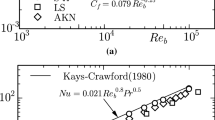Abstract
In the present study, a high Reynolds number version of a turbulence model was proposed by using drag reduction to analyze the turbulent flows of power-law fluid for engineering applications. In order to determine the model constants in the constitutive equation, numerical simulation was conducted under the same conditions that were applied to obtain the experiment results and previous turbulence models. For validation of the modified turbulence model, numerical simulations were performed for power-law fluids of different viscosities. The results of the modified k-ɛ turbulence model showed better agreement with the experimental results than those of the standard k-ɛ turbulence model. In addition, computation time and computer resource of the modified k-ɛ turbulence model were reduced by about one third as compared to the low Reynolds number model for power-law fluids.
Similar content being viewed by others
References
Toms B A. Some observations on the flow of linear polymer solutions through straight tubes at large Reynolds numbers. Proceedings of the 1st International Congress on Rheology, 1948, 11: 135–141
Azouz I, Shirazi S A. Numerical simulation of drag reducing turbulent flow in annular conduits. J Fluid Eng-T ASME, 1997, 119(4): 838–846
Hoyt J W. Effect of additives on fluid friction. J Basic Eng-T ASME, 1972, 94(2): 258–285
Lumley J L. Drag reduction in turbulent flow by polymer additives. J Polym Sci Part D, 1973, 7: 263–290
Virk P S. Drag reduction fundamentals. AIChE J, 1975, 21(4): 625–656
Dodge D W, Metzner A B. Turbulent flow of non-Newtonian systems. AIChE J, 1959, 5(2): 189–204
Meyer W A. A correlation of frictional characteristics for turbulent flow of dilute viscoelastic non-Newtonian fluids in pipes. AIChE J, 1966, 12(3): 522–525
Virk P S. An elastic sublayer model for drag reduction by dilute solutions of linear macromolecules. J Fluid Mech, 1971, 45: 417–440
Poreh M, Diamant Y. Velocity distribution and friction factors in pipe flows with drag reduction. Proceedings of 9th International Symposium on Naval Hydrodynamics, 1972, 2: 1305–1323
Hassid S, Poreh M. A turbulent energy model for flows with drag reduction. J Fluid Eng-T ASME, 1975, 97(2): 234–241
Hassid S, Poreh M. A turbulent dissipation model for flows with drag reduction. J Fluid Eng-T ASME, 1978, 100(1): 107–112
Pinho F T, Whitelaw J H. Flow of non-Newtonian fluids in a pipe. J Non-Newton Fluid, 1990, 34(2): 129–144
Harder K J, Tiederman W G. Drag reduction and turbulent structure in two-dimensional channel flows. Phil Trans R Soc Lond A, 1991, 336: 19–34
Wei T, Willmarth W W. Modifying turbulent structure with drag-reducing polymer additives in turbulent channel flows. J Fluid Mech, 1992, 245: 619–641
Den Toonder J M J, Hulsen M A, Kuiken G D C, et al. Drag reduction by polymer additives in a turbulent pipe flow: Numerical and laboratory experiments. J Fluid Mech, 1997, 337: 193–231
Escudier M P, Presti F, Smith S. Drag reduction in the turbulent pipe flow of polymers. J Non-Newton Fluid, 1998, 81(3): 197–213
Ptasinski P K, Nieuwstadt F T M, Van Den Brule B H A A, et al. Experiments in turbulent pipe flow with polymer additives at maximum drag reduction. Flow Turbul Combust, 2001, 66(2): 159–182
Pinho F T. A GNF framework for turbulent flow models of drag reducing fluids and proposal for a k-ɛ type closure. J Non-Newton Fluid, 2003, 114(23): 149–184
Malin M R. Turbulent pipe flow of power-law fluids. Int Commun Heat Mass, 1997, 24(7): 977–988
Malin M R. PHOENICS simulation of the turbulent flow of Herschel-Bulkley fluids in smooth pipes. The PHOENICS J Comp Fluid Dynam Appl, 1999, 12(4): 351–367
Shenoy A V, Saini D R. A new velocity profile model for turbulent pipe-flow of power-law fluids. Can J Chen Eng, 1982, 60(5): 694–696
Patel V C, Rodi W, Scheuerer G. Turbulence models for near-wall and low Reynolds number flows. AIAA J, 1985, 23(9): 1308–1319
Escudier M P, Oliveira P J, Pinho F T. Fully developed laminar flow of purely viscous non-Newtonian liquids through annuli, including the effects of eccentricity and inner-cylinder rotation. Int J Heat Fluid Fl, 2002, 23(1): 52–57
Ro K C, Ryou H S. Numerical study on turbulent blood flow in a stenosed artery bifurcation under periodic body acceleration using a modified k-ɛ model. Korea-Aust Rheol J, 2010, 22(2): 129–139
Author information
Authors and Affiliations
Corresponding author
Rights and permissions
About this article
Cite this article
Ro, K., Ryou, H. Development of the modified k-ɛ turbulence model of power-law fluid for engineering applications. Sci. China Technol. Sci. 55, 276–284 (2012). https://doi.org/10.1007/s11431-011-4664-x
Received:
Accepted:
Published:
Issue Date:
DOI: https://doi.org/10.1007/s11431-011-4664-x




